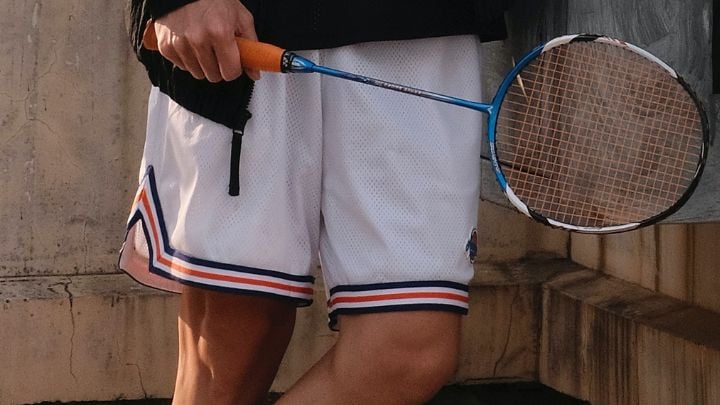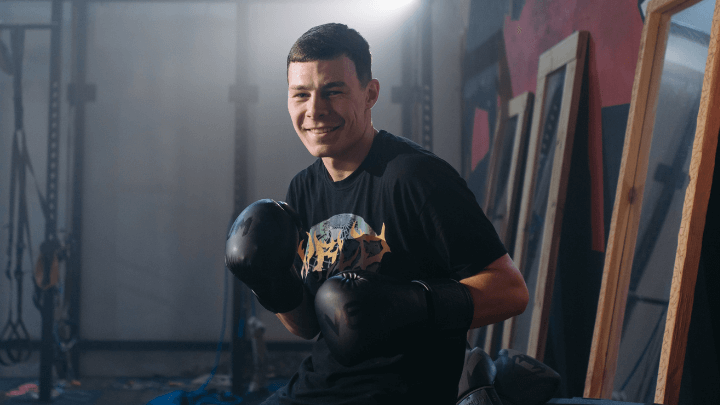
In this guide, I’m not only going to show you what the top 11 most common jab mistakes are, but also explain why they are mistakes and what the solution is.
Ready to improve your jab?
Let’s dive right in.
1. Chicken Wing Elbows
What Is the Chicken Wing Elbows?
The chicken wing is when your elbows are sticking out too much during the jab. It is caused by internally rotating your shoulders in too early in the punch.
Why Is Chicken Wing Elbows a Problem?
The reason why this is a mistake is because your jab would be too slow and your opponent would be able to see your stuck out elbow from a mile away.
What Is the Solution?
To fix this problem, rotate your shoulder, forearm, and hand right at the end of the punch (not at the beginning).
This will help you punch in one straight line, from your chin to your opponent’s chin.
2. Winding-Up the Jab (Telegraphing)
What Is Telegraphing?
Telegraphing is where you give signals to your opponent that you’re about to punch.
These signals can include raising your arm before punching, winding up a punch, and rotating your shoulders inwards too early.
Note: Fainting commonly gets confused with telegraphing but they are two different things. Fainting is deliberately fooling your opponent into thinking you’re about to make a punch whereas telegraphing is unintentional and slow.
Why Is Telegraphing a Problem?
Telegraphing is a problem because your opponent would be able to see your punch coming from a mile away and this would therefore mean you might miss and get hit in return.
What Is the Solution?
The solution is to throw your jab from your chin to your opponents face in one straight line.
By avoiding a big wind-up or raised arm, you are able to throw the jab much faster and are more likely to hit your opponent.
3. Jabbing in Close Range
What Is Jabbing in Close Range?
Jabbing in close range is when you jab your opponent within an arm’s length (punching range).
Why Is Jabbing in Close Range a Problem?
It’s a problem because you’re unable to get full extension in your jab (a long-range punch), therefore not being able to generate as much power into the punch.
It’s like pulling back a catapult half-way, you’ll find that the rock doesn’t go very far, just in the same way that the jab wouldn’t do much.
What Is the Solution?
The solution would be to only throw in-range punches (these are your lead hooks, rear hooks, lead uppercut, and rear uppercut punches to the body and head).
4. Jabbing Across Your Body
What Does Jabbing Across Your Body Mean?
Jabbing across your body means jabbing too far to the right (if you’re in orthodox stance) or jabbing too far to the left (if you’re in southpaw stance).
Why Is Jabbing Across Your Body a Problem?
Because you will likely miss your opponent and likely get countered. You’ll also find it harder to retract your jab if it’s off in the wrong direction.
What Is the Solution?
Jab in a straight line from your chin to your opponent’s chin.
5. Not Rotating Your Arm
What Is Underrotating Your Arm Mean?
Underrotating your arm means that your arm isn’t twisting inwards enough towards the end of the punch.
Why Is Underrotating Your Arm a Problem?
Underrotation is a problem because it can reduce the amount of power you’re able to generate with the punch and may injure your elbow with hyperextension.
What Is the Solution?
Rotate your shoulder, elbow, forearm, and wrist halfway through your jab in order to generate the maximum snap and prevent chicken winged elbows (see common mistake no. 1 above).
6. Not Using the Jab Often Enough
What Does Infrequent Jab Use Mean?
Infrequent jab use means not throwing the jab consistently when fighting.
Why Is Infrequent Jab Use a Problem?
The jab should be the most thrown punch in your arsenal because it helps you find your range, set up punch combinations, and stun your opponent.
What Is the Solution?
The solution is to jab your opponent more, particularly when you’re unsure as to whether you are in or out of range.
7. Lazy Retractions
What Does Lazy a Retraction Mean?
A lazy retraction is when your punch is too slow to retract (withdraw) back to its original position. Here is an example of Angulo doing this against Canelo:
Why Are Lazy Retractions a Problem?
Lazy retractions are a problem because if you throw any punch and retract your arm slowly, you’re open to being hit by an unprotected counter.
Furthermore, Lazy retractions also slow down your follow up combos because your body won’t be able to generate good rotation if one arm is already out in front of you.
What Is the Solution?
When you throw a punch, bring it back to your original guard as quickly as you threw it. This way, you will eliminate the slow and lazy retraction.
8. Not Extending Your Arm
What Does Underextending Your Arm Mean?
Under extending your arm is where your punching arm is not fully extended out (locked out) in front of you.
Why Is Underextending a Problem?
By not extending your punch, you will not be able to generate as much power and snap.
Furthermore, your retraction will be slower and you won’t be able to cover as much distance.
What Is the Solution?
Consciously focus on extending your arm out completely the next time you’re hitting the heavy bag/shadow boxing.
9. Not Tucking Your Chin
What Does Untucking Your Chin Mean?
Untucking your chin simply means to not tuck your chin when throwing a punch.
Why Is Untucking Your Chin a Problem?
Tucking your chin is vital for not being hit, by untucking it, you leave your jaw/tempel exposed to counters which could knock you out.
What Is the Solution?
Bring a tennis ball to your next session and try your best to keep it under your chin as you throw punches at the heavy bag (see video above).
This will build a good habit of tucking your chin.
10. Overcommitting the Jab
What Does Overcommitting the Jab Mean?
Overcommitting is where you put too much kinetic energy into the punch and as a result, becoming off balance and leaning forward too much.
Why Is Overcommitting the Jab a Problem?
Because fighting is all about keeping your balance. If you get hit with the majority of your weight on the front foot, then you have less control and will likely get knocked down/hit cleanly.
Tip: The majority of your weight should be on your back foot when fighting.
What Is the Solution?
Go back to the basics when training again by starting with the standing jab.
Film yourself to see if your weight is balanced as you progress on jab variations (power jab, jab to the body, step jab, spear jab, etc).
Click to tweet these common jab mistakes. ?
Why Do Fighters Make Mistakes With Their Jabs?
There are a number of reasons why a fighter can make mistakes with their jab, some of the reasons include:
1. Lacking boxing experience: It takes years for a fighter to master a jab.
2. Mindless practice: There are two types of practice. Mindless practice, and deliberate practice. Mindless practice is where an athlete doesn’t focus on what he is doing, and it operating unconsciously. Deliberate practice (coined by psychologist Anders Ericsson) is where you are consciously focusing on what you’re doing over and over again, with the goal to improve.
“Punching with deliberate practice is far harder than punching with mindless practice.”
3. Having a bad boxing coach: Some coaches just aren’t that good at showing you the deep technical details of a punch because they are not aware of it in the first place. Look for boxing gyms where the coaches have worked with successful professional fighters who are good at avoiding mistakes.
4. Fighters are human too: Everyone makes mistakes. Boxing and life are about becoming so good that you make less of them.
Great and relevant book: So Good They Can’t Ignore You: Why Skills Trump Passion in the Quest for Work You Love by Cal Newport
Conclusion
Everyone makes mistakes, I hope that this guide helps you make fewer mistakes in your jabs.
Now I’d like to turn it over to you:
- What jabbing mistake have you made in the past? (I used to have a chicken wing elbow problem.)
- Is the jab the most important punch in boxing?
- Perhaps you’d like to ask a question or offer missing advice?
Either way, let me know by leaving a comment below or by messaging me on Instagram.






